
Official Publication of the Illinois Nurses Foundation Quarterly publication direct mailed to approximately 4,500 RNs and electronically via email to 96,000+ RNs in Illinois.


Official Publication of the Illinois Nurses Foundation Quarterly publication direct mailed to approximately 4,500 RNs and electronically via email to 96,000+ RNs in Illinois.
The Illinois Nurses Foundation (INF) held its annual Holiday Fundraising Gala on December 3rd, 2022, at the DoubleTree by Hilton in Lisle. It was a joyful evening for the Foundation and all those that came to celebrate. Various organizations and supporters of the Foundation purchased entire tables for the event, which provided an excellent way to spend time with friends and family during the holiday season while supporting a great cause. The event offered the perfect blend of holiday cheer, networking, and excitement with the online silent auction, giving tree, raffles, and the 50/50 cash giveaway. Thanks to the overwhelming support of all the attendees, the Gala raised over $25,000!
Each year the Foundation's "Honor a Nurse" campaign grows. The project was designed to Honor nurses who have fought for the advancement of the profession and who inspire others to recognize their commitment to their patients and the work they do every day.
Nominations for the "Honor a Nurse" campaign were received throughout the year. The outpouring of stories collected were reviewed and narrowed down to five finalists, chosen by the Foundation Board members.

The 2022 Nurse of the Year award was then presented to Jackie Kelley. The story submitted to honor her read: Jackie Kelley is a fantastic nurse, provider, educator, and advocate at Loyola Medical Center, where she has worked for 17 years. She started her nursing career in the Burn ICU and then, after ten years, transferred to the Trauma Department, where she is the Performance Improvement Coordinator. In this role, Jackie has become an expert in collecting, analyzing, and communicating data, which is used to guide the care of our patients. She monitors all trauma cases for patient care and process improvement opportunities. She has developed spreadsheets and dashboards to communicate the data she manages. These dashboards and worksheets are a cornerstone of the Trauma QI Program. She is an expert resource to the physician and data entry team for tracking outcomes and helping to guide patient care
and data integrity processes. She is an unsung hero in ensuring our patients get the best care possible. She recently graduated with her MSN, FNP-BC, and she looks forward to her work as a nurse practitioner in women's health services. Just as in her current role, her future patients will be blessed with excellent care from Jackie. These reasons and more make her an excellent candidate for the Nurse of the Year.
The other finalists included Diane Ferriss BSN, RN, Dan Fraczkowski MSN, RN-BC, Amelia Perez PhD, RN, and Jennifer Sandoval MSN, RN. The stories submitted to honor them read:
Diane Ferriss BSN, RN
Diane Ferriss is a gem of a public health nurse. I've seen her consistently care for clients with extraordinary active listening skills, empathy, and compassion while guiding clients toward well-being. Navigating clients' barriers are embedded in her nursing practice. Diane has worked in maternal/child care for many years as a case manager, Nurse-Family Partnership nurse, and supervisor. With Diane's guidance, I recall that one of her clients overcame barriers as a first-time single mom to become a nurse herself. Diane is a flexible - step up to the challenge - public health nurse. When asked to provide immunizations, she stepped up. Check— emergency preparedness. Check—new, complicated federal programs. Check. COVID-19 education. Check. COVID-19 vaccination clinic. Check—behavioral health care. Her public health nursing practice is carried out with a spirit of humility and servanthood. For these reasons, I nominate Diane Ferriss for the Nurse of the Year Award.
Dan Fraczkowski MSN, RN-BC
Dan is an individual who continually gives back to the nursing profession. He is a past president of ANAIllinois, current Nominations and Elections Committee member for ANA-Illinois. He is one of the ANA-Illinois Co-Consultants to the Student Nurses Association of Illinois (SNAI). Even though he is working on his PhD he gives back to every generation of nursing. Dan has been one of my mentors since I was a student. He took me under his wing when we met at an SNAI conference way back in, probably sometime close to 2013. He encouraged me to apply for the SNAI board, then become an ANA-Illinois board member and SNAI consultant, all the way up to being an ANA Board member. Dan works hard for the nursing community to ensure that accurate, straightforward information and data are given. In nursing informatics, he is bringing to light how we can improve nursing and documentation for all. His representation at the ANA Membership Assembly also brings new comments, ideas, and action.

Amelia Perez PhD, RN
Dr. Perez is a dedicated educator who teaches, inspires, and mentors her students at SIUE and within our NAHN-Illinois membership. She represents our mission, vision, and passion for enlightening and motivating the future of nursing. Dr. Perez using her nursing background, research, and community service, has focused on many issues that ethnic minorities and underserved communities face that impact their health. She has demonstrated a deep passion and commitment to service via volunteerism and community service. She shares her expertise and wisdom to support and leads the chapter in addressing health disparities. Dr. Perez is stellar and promotes a vision of healthcare advancement in Illinois and nationally by serving as a leading voice in nursing. I am honored to nominate her for the Nurse of the Year.
Jennifer Sandoval MSN, RN
Jennifer is dedicated to the nursing profession. As a bedside nurse, she goes above and beyond for our Veteran patients. She always wants only the best for
Recently I was reading an article discussing the expected trends in nursing in 2023. Some of the expected trends did not surprise me, but others I found quite interesting. It made me think about how we as nursing professionals are preparing for the future of nursing. It also made me think about the IL Nurses Foundation (INF) and the direction of the Foundation in 2023.
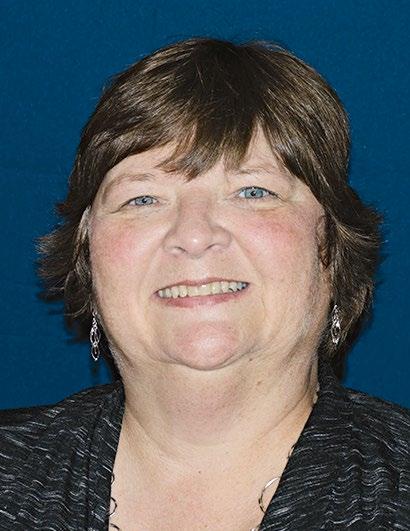
Cheryl Anema PhD, RN
The INF Board of Directors decided in late 2021 to look at the Foundation, where we started, where we are, and where we want to be in the future. At the time the INF hired a strategic consultant to work with us and guide us in our direction and strategic planning. This work continues and we should see some great changes and growth in the Foundation throughout 2023. The timing is right!
Nursing as a profession is also at a pivotal point as key healthcare leaders have recognized the need for nursing

What is projected according to the U.S. Bureau of Labor Statistics, the job growth rate for RNs through 2031 is 6% and the estimated growth rate for nurse practitioners (NPs) is 40%. Additionally, the supply of new nurses is directly related to a shortage of nursing faculty. According to the American Association of Colleges of Nursing, 91,938 qualified applicants were turned away from baccalaureate nursing programs in the 2021-2022 school year. Most schools said they could not admit qualified candidates due to insufficient faculty, clinical sites, and preceptors.
The INF is investing in nursing education by offering nursing student scholarships. These scholarships are not only available to students in a basic program for nursing (ADN, BSN...), but also for graduate studies (MSN, DNP, PhD). The INF also offers Grants to help seed research by practicing nurses, faculty, and graduate nursing students.
On top of this, the pandemic has taken its toll on nursing professionals mental health, especially bedside nurses. Many nurses have experience nurse burnout due to the continued high-stress work environments. The nursing shortage has added to the stress by requiring nurses to work massive over-time hours, and care for heavy client workload assignments with more complex healthcare needs. This change in workplace stress is a primary driver in the mass exodus of nurses in 2022. This nursing shortage and professional stress is expected to intensify through 2023. In order for nurses to take care of others, they must first take care of themselves. It is essential for each nurse to recognize the signs of burnout or stress and identify resources to help improve their sleep quality or guide them through meditation, exercise, journaling, or expressing gratitude. Each of these factors can help protect mental health and lower burnout rates.
Considering leadership?
Our Master of Business Administration offers concentrations in healthcare and sports/exercise management. For more info, visit neiu.edu/mba Our Master of Public Health has a management option. Learn more at neiu.edu/mph

INF Board of Directors
Officers
Cheryl Anema, PhD, RN
Brandon Hauer, MSN, RN
Karen Egenes, EdD, RN
Directors
Maureen Shekleton, PhD, RN, DPNAP, FAAN
Linda Olson, PhD, RN, NEA-BC
Amanda Oliver, BSN, RN, CCRN
ANA-Illinois Board
Rep
Susana Gonzalez, MHA, MSN, RN, CNML
Jeannine Haberman DNP, MBA, RN, CNE
Zeh Wellington, DNP, MSN, RN, NE-BC

ANA-Illinois Board of Directors
Officers
Elizabeth Aquino, PhD, RN
Monique Reed, PhD, MS, RN
Jeannine Haberman, DNP MBA, RN, CNE
Beth Phelps, DNP, APRN, FNP, ACNP
Directors
Samuel Davis Jr MHA, RN, CNOR
Susana Gonzalez, MHA, MSN, RN, CNML
Elaine Hardy, PhD, RN
Hannah Shufeldt MSHCM, BSN, RN
Zeh Wellington, DNP, MSN, RN, NE-BC
Editorial Committee
Chief Editor
Lisa Anderson-Shaw, DrPH, MA, MSN
Members
Cheryl Anema PhD, RN
Deborah S. Adelman, PhD, RN, NE-BC




Danville Area Community College is Hiring a Director of Nursing Education
The Director of Nursing Education participates in the overall development of policies and procedures pertaining to the planning and implementation of activities that will enable the nursing programs to meet all state accreditation requirements for all nursing education programs.
Qualifications:
Masters degree or higher with a major in Nursing Licensed as a registered professional nurse in Illinois At least 2 years’ experience as an instructor in an RN or higher nursing education program
Danville Area Community College is an accredited public two-year college that serves more than 8,000 students annually. The College is located in Danville, in east central Illinois, 125 miles south of Chicago and 90 miles west of Indianapolis and enjoys a campus of 75 beautiful acres. DACC is an equal opportunity/affirmative action employer. For more information and to apply, please visit DACC’s website at: www.dacc.edu/hr
The INF is working closely with the ANA-IL in providing resources to promote nursing, offer continued educational opportunities for nurses to meet the changing needs of the profession, support nursing research, and a renewed focus on nursing mental health. The Nursing Voice (the professional publication of the INF) will be focusing on some these timely trends throughout the year. If anyone is interested in writing an article for the Nursing Voice that may deal with any of the new trends in nursing, please send in your manuscript for review.

PhD, RN; President, INF


If you are looking for an opportunity that’s more than just a job where love and care for children are the most important, then, childhabcenter.com You Can Be A Part of the Miracles! click here to learn more
Linda Anders, MBA, MSN, RN
Ellen Bollino MSN, RN, ED, CEN
Nancy Brent, RN, MS, JD
Pamela DiVito-Thomas PhD, RN
Amanda Hannan MSN, RN
Irene McCarron, MSN, RN, NPD-BC
Linda Olson, PhD, RN, NEA-BC
Lanette Stuckey, PhD, MSN, RN, CNE, CMSRN, CNEcl, NEA-BC
Executive Director
Susan Y. Swart, EdD, MS, RN, CAE
ANA-Illinois/Illinois Nurses Foundation
Article Submission
• Subject to editing by the INF Executive Director & Editorial Committee
• Electronic submissions ONLY as an attachment (word document preferred)
• Email: syswart@ana-illinois.org
• Subject Line: Nursing Voice Submission: Name of the article
• Must include the name of the author and a title.
• INF reserves the right to pull or edit any article / news submission for space and availability and/or deadlines
• If requested, notification will be given to authors once the final draft of the Nursing Voice has been submitted.
• INF does not accept monetary payment for articles.
Article submissions, deadline information and all other inquiries regarding the Nursing Voice please email: syswart@ ana-illinois.org
Article Submission Dates (submissions by end of the business day) January 1st, April 1st, July 1st, October 1st
Advertising: for advertising rates and information please contact Health eCareers, HEC_Nursing_Info@healthecareers.com
ANA-Illinois and Health eCareers reserve the right to reject any advertisement. Responsibility for errors in advertising is limited to corrections in the next issue or refund of price of advertisement.
Acceptance of advertising does not imply endorsement or approval by the ANA-Illinois and Illinois Nurses Foundation of products advertised, the advertisers, or the claims made. Rejection of an advertisement does not imply a product offered for advertising is without merit, or that the manufacturer lacks integrity, or that this association disapproves of the product or its use. ANA-Illinois and Health eCareers shall not be held liable for any consequences resulting from purchase or use of an advertiser’s product. Articles appearing in this publication express the opinions of the authors; they do not necessarily reflect views of the staff, board, or membership of ANA-Illinois or those of the national or local associations.
her patients and promotes change by joining hospital committees and projects that will only better the care for her patients.

As an educator, she supports and encourages our future nurses. Students form a connection with her and contribute to their success. She believes in her students and encourages them to give back to the community. She enjoys partaking in community engagement and encourages her students to join her. She participates in vaccination clinics through DePaul University and via the National Association of Hispanic Nurses. She also volunteers with the Make A Wish foundation as a wish granter for children battling critical illnesses. She is a member of the National Hispanic Nurses Association, Sigma Theta Tau, and the American Nurses Association. I am honored to nominate her for the Nurse of the Year Award.
This year, the INF Board of Directors awarded Joan Bundley the inaugural Lifetime Achievement Award.
Joan Bundley
Joan Bundley is known to many of those at the event. She is a "Nurse's Nurse for the Ages." She has cared for and mentored hundreds of nurses who have served as leaders in Illinois. Many of those wrote to the INF Board of Directors, asking that she be recognized. Her contributions to nursing have occurred over a long, productive, and distinguished career as both a nurse
PLATINUM SPONSORS - $2500
ANA-Illinois
HealtheCareers
Loyola Medicine
DIAMOND SPONSOR - $1000
MaryAnn Tuft
GOLD SPONSORS - $500
CeraVe
Old National Bank
Dr Linda Olson
Dr Karen Egenes
SILVER SPONSORS - $250
Casey's
Dam Snell & Taveirne LTD
BRONZE SPONSORS - $100
Dr Pam DiVito-Thomas
Smits Funeral Home
Stepping Stone Financial
Walter W Schultz Insurance Agency
Witkowski Dental
TABLE SPONSORS
Advocate Aurora Health
Dr Jose Alejandro
Dr Cheryl Anema
Dr Maria Connolly
Lewis University
National Association of Hispanic Nurses-Illinois
Amanda Oliver
Philippine Nurses Association of Illinois
Dr Maureen Shekleton
SYS Consulting Solutions Inc
RAFFLE/SILENT AUCTION DONORS
Accelerate Indoor Speedway
All About Word Art
Lisa Anderson-Shaw
Cheryl Anema
Attitute Beadsmetreasures
Benihana
Bettie s Chicago
Blackberry Café
Pam Brown
Buca di Beppo
Nadine Butler
The Burnt Branch
Caesar’s Harrah Joliet
Cheesecake Factory
Chicago Bears
Chicago Multicultural School of Dance
Chicago White Sox
Chicago Wolves
Lisa Conley
Cooper s Hawk
Costco
CR Fundraising Consultants
CVS Marilou Dangalan
DVDesign
Karen Egenes
El Salto Mexican Restaurant
Emagine Theater
Float Sixty Fogo de Chao
Emagine Theater
Float Sixty
Fogo de Chao
Fresh Meadow Golf Club
Yolanda Frontany
Giordano’s Go Ape
Susana Gonzalez
Gordon Food Service
Brandon Hauer
Holiday World & Splashin’ Safari
Thumbed Treats
Trader Joes
Van Der Griend Farmstand
Walt's Food Center
Web City Shop
Monica Wiley
Chakika Williams Zanies
International Museum of Surgical Science
The James Dyson Foundation
Jameson's Restaurant
JC Franchise International
Karen Kelly
Kendra Scott Jewelers
Lake Geneva Gage Cruise Line
Laxy Dog Restaurant
Let s Roam
Lettuce Entertain You
Linea Hair Salon & Day Spa
Lara Long
Longhorn Steakhouse
M & J monograms
Marriott Theater
Maureen Shekleton
Kim Mettache
Meijer
Catherine Mombrun
Museum of Contemporary Art
Navy Pier
Northlight Theatre
NurseInTheMaking
Amanda Oliver
Olivet Nazarene University
Oriental Trading Company
Outback Steakhouse
Para-A-Dice Hotel & Casino
PRP Wine International
Queen Bean Coffee Company
Raising Cane’s
Rivers Casino
Rockford Symphony Orchestra
Ruthann Sanders
Salt Caves
Sanders Fine Portraits
Laurel Schaap
Shining Pearl Clothing
Shipshewana Farmstead Inn
Simply Shaunece s Creations
Sprinkles
St Louis Cardinals
St Louis Six Flags
Susan Y Swart
Tamarack Golf Club
Target
Texas Roadhouse
Theo's Restaurant
and a parliamentarian. She is widely recognized for her expertise and dedication to both. She has supported many initiatives that advanced the scope and practice of nursing through both direct and indirect advocacy. Her many years of service as an Illinois Nurses Association staff member required her to speak directly on behalf of the profession in the legislative, regulatory, and public arenas. Her indirect advocacy was demonstrated through her mentorship of so many of us, who drew on her expertise about the issues and the processes by which we could influence them. One individual wrote, "I have often thought of her and what she has done for nursing & especially what she has done for me as an individual. I also know that she hates, HATES being recognized for doing what she has done & continues doing. I think that her most important job has been support - she excelled as a mentor of members and member leaders. She has helped so many nurses be "heard."
The INF strives to make this event a MUST ATTEND for all those in the nursing profession and its supporters. A very special thank you to each of our major sponsors, many donors, and the volunteers who worked to make this event a success. Thank you for all that you do to support Illinois Nurses Foundation!















Dear Illinois Nurse Colleagues, Wishing you a Happy and Healthy New Year!

Linda L. Olson, PhD, RN, NEA-BC, FAAN
Lisa Anderson-Shaw, DrPH, MA, MSN

Liz Aquino, PhD, RN
ANA-Illinois is off to a great start by welcoming its inaugural class participating in the Nurses Running for Elected Office (NREO) training academy! This six-month training academy provides training and resources for nurses interested in running for elected office at the local, state, and federal levels. We are proud of the members participating in this inaugural class, they are already changemakers in their professional achievements and we look forward to supporting them as they share their experiences, knowledge, and nursing perspective in elected office!
We hope you will join us for our annual events including Nurses Day at the Capital on March 7, 2023 and Student Nurse Political Action Day on April 18, 2023. Both events will be held in-person in Springfield. We look forward to a productive year advancing legislation that advances nursing priorities and improves healthcare for all.
To learn more about events and opportunities to get involved—check out our website (ana-illinois.org) or social media platforms (fB, Instagram, LinkedIn, and Twitter). Don’t forget to tag us so that we can help promote the great work you are doing both professionally and personally!
I look forward to another year of continuing to represent and serve Nurses in Illinois.
Sincerely,

Elizabeth (Liz) Aquino, PhD, RN President, ANA-Illinois @LatinaPhDRN
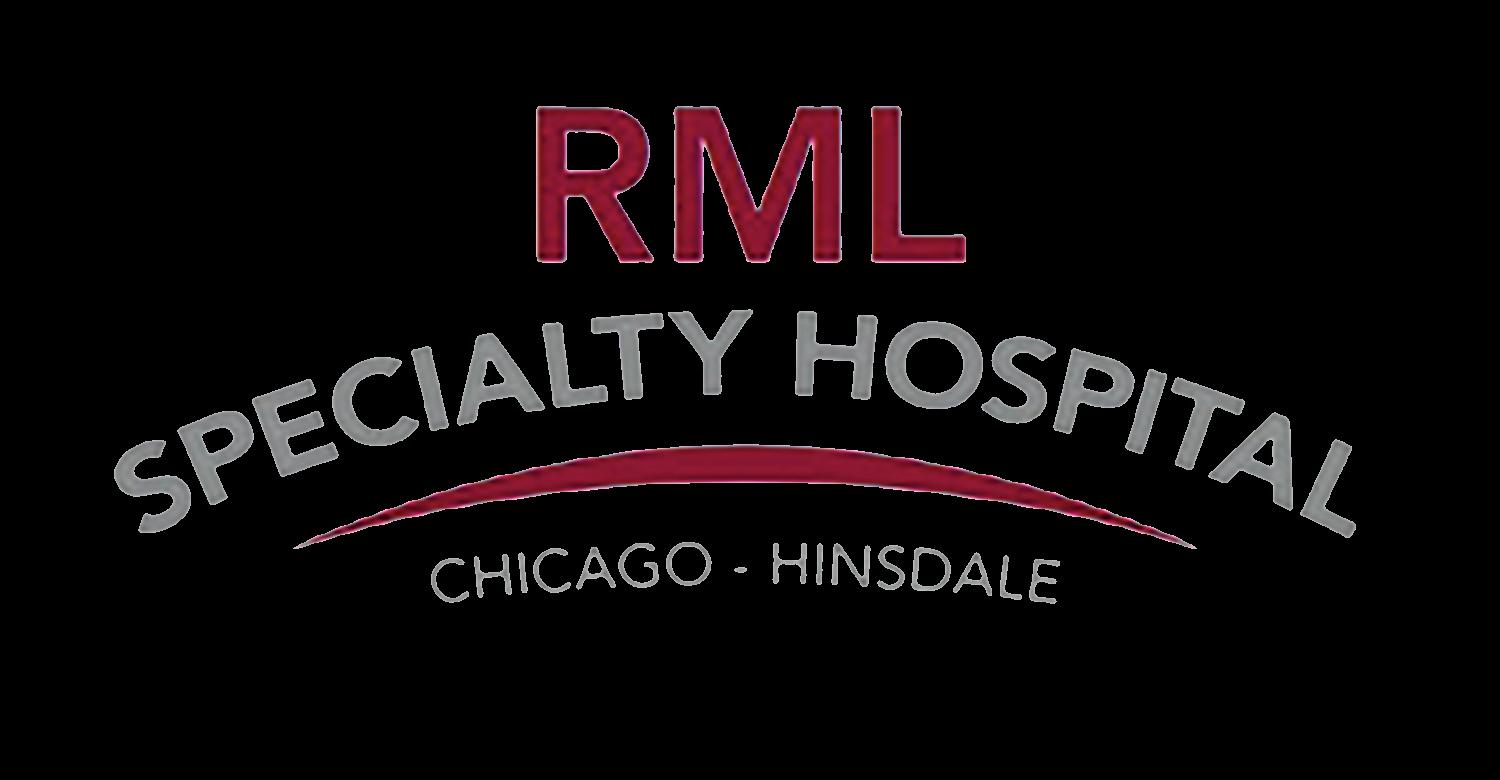
Hinsdale, IL 60521 or Chicago, IL 60624
contact: dmalone@rmlsh.org


The emerging information and technologies associated with genetics and genomics present unique ethical challenges for nursing, and for nursing education. While genetics is the study of individual genes and associated disorders, genomics refers to the study of all genes in the human genome, which is an individual’s entire genetic composition. The Human Genome Project (HGP), an international research effort completed in 2003, mapped all the genes in the human body. More recently, the 1000 Genome Project was an international collaboration of researchers who examined the sequencing of genomes of people from different ethnic groups to create a catalog of genetic variations (2015). With the increasing knowledge about genetics and genomics and their application to healthcare, it is important that nurses be aware of and able to incorporate the emerging evidence into their practice. How can the ANA Code of Ethics for Nurses with Interpretive Statements (2015) serve as a resource for nurses’ professional responsibilities related to genetics and genomics?
Provision 3 of the Code of Ethics states that “the nurse promotes, advocates for, and protects the rights, health, and safety of the patient,” with 3.1 focused on protection of the rights of privacy and confidentiality (2015, p. 9). The discoveries from human genetic research, as well as from the associated emerging technologies such as genetic testing, creates concerns that result in an increased interest in people seeking information and genetic counseling, thereby also resulting in genetic dilemmas. Nurses have an ethical responsibility and obligation to protect patients’ privacy. The potential for genetic discrimination in the workplace and for insurance purposes is of particular concern and heightens the importance of protecting patient privacy and confidentiality. Patients also have concerns about how much of their individual genetic information they are obligated to share with family members. Another ethical issue in nurse’s role in genetics and genomics is related to the importance of informed consent.

There are resources on genetics and genomics related to nursing education and practice. The ANA Scope and Standards of Practice for Genetics/Genomics Nursing (2016) was written and updated by genetics/ genomics nurses from ANA and the International Society for Nurses in Genetics (ISONG) and is applicable to the RN and APRN in genetics/genomics at any level. ISONG has developed position statements regarding genetics/ genomics and the role of the nurse, especially related to the privacy and confidentiality of genetic information (https://www.isong.org).
There are several applications of genetics and genomics, including personalized and precision medicine, pharmacogenetics that leads to drugs that are tailored to individuals based on their genetic makeup, and genetic testing. Genetic testing is available for many genetic conditions and can be used to learn whether an individual or family have a genetic predisposition to diseases, to diagnose a genetic condition, or to understand and guide a prevention or treatment plan. Genetic testing and assessment are particularly important in cancer prevention, diagnosis, and treatment. A relatively new type of testing, called direct-to-consumer genetic testing, provides people access to their genetic information for a variety of purposes without going through healthcare providers such as physicians, nurse practitioners, or genetic counselors, and insurance companies. Most direct-to-consumer testing companies provide their privacy practices on their website. The Centers for Disease Control and Prevention (CDC) is a resource on genetic testing and genetic conditions. (https://www.cdc. gov/genomics/gtesting/genetic_testing.htm).
Nurse educators are especially important in promoting the use of genetics in practice and in education. The increasing knowledge being gained through genetic research will continue to generate new and emergent ethical issues. Nurses in all roles and settings must be knowledgeable and open to meeting the resulting challenges.
References
American Nurses Association. (2015). ANA Code of Ethics with Interpretive Statements. Nursesbooks.org
American Nurses Association. (2016). Scope and Standards of Practice for Genetics/Genomics Nursing (2nd ed.). Nursesbooks.org
Centers for Disease Control & Prevention. (2022). Genetics testing. https://www.cdc.gov/genomics/gtesting/genetic_ testing.htm
International Society for Nurses in Genetics. (2018). Informed decision-making and consent related to genetic testing (clinical and research): The role of nursing. https://www. isong.org/resources/Documents/Informed%20decision%20 making%20position%20statement%20approved%20Dec%20 2018.pdf

Cassandra Ma, Psy.D.
One in every three victims of human trafficking and forced labor is a child (United , 2020). Notably, when a person younger than 18 is used to perform a commercial sex act, it is a crime regardless of whether there is any force, fraud, or coercion. A potential safety-net falls for these child trafficking victims within healthcare settings because these are the primary sites for potential identification and intervention. Most victims come to the attention of healthcare professionals during the course of trafficking and child trafficking is a mandated reporting responsibility of healthcare providers in many states (English, 2017). Two major forms of trafficking are labor and sex trafficking, though, child sex trafficking differs from any form of trafficking of adults and child labor trafficking in that any minor engaged in commercial sex is considered a victim of sex trafficking regardless of force, fraud, or coercion. This notable distinction is important due to the implicit acknowledgement that children cannot give consent to commercial sex. Beyond the definitional differences, developmental factors are important to consider when developing awareness and intervention strategies to assist victims.
The literature provides evidence that suggests between 68% and 87% (Chrisolm-Straker et al., 2016; Lederer & Wetzel, 2014) of trafficking survivors visit a healthcare professional during trafficking. To maximize the healthcare professional’s role in intervening during encounters with potential victims it is important to understand the developmental trauma associated with child trafficking and the complex trauma originating from child victimization. Child trafficking involves abuse and exploitation by an adult against a child. Children are dependent upon adults for all aspects of survival, including caregiving, for shelter, food, and protection. As such, the distortion of the adult’s role in the life of the child does not change the child’s dependency needs but, instead, shapes the child’s perspectives about relationships with adults. Trafficked youth are frequently mistrustful of adults.
Misconceptions of child trafficking suggest children are held captive or physically restrained when, in most cases, child victims remain integrated in schools, communities, and other aspects of mainstream society. Child trafficking typically begins with a relationship that fulfills the need children have for adult protection, caregiving, or affection (Hopper, 2017). Child trafficking in the United States is more accurately understood as an exploitation of a child through the abuse of the adult responsibility to care for the child.
Predators use grooming tactics to foster relationships that, later, become exploitative. Grooming describes the tactics of traffickers to cultivate relationships that take advantage of the child’s vulnerabilities and attachment needs (Wood, 2020). Children are, by virtue of their dependent status, more vulnerable to exploitation. For example, children cannot get money to buy food or find shelter, they are dependent upon adults to meet these survival needs. Additionally, children are more readily victimized because they are less physically, emotionally, cognitively developed. When these needs are met, even minimally, an attachment relationship begins.
Coercive control tactics are commonly gradually introduced. Children are less capable of identifying the gradual shift in relational dynamics as attachments strengthen. Due to their size and less developed physical stature, overt physical violence is not always
necessary to gain the compliance of a child victim. In one study of perpetrator tactics, only 32.5% reported the use of physical force (Stalans & Finn, 2016). Many coercive tactics are not physically abusive, but are, instead, psychologically coercive (Baldwin et al., 2015). Psychological coercion includes isolation, monopolization of perception, induced debility or exhaustion, threats, occasional indulgences, demonstration of omnipotence, degradation, and enforcement of trivial demands (Baldwin et al., 2015). Trauma-coercive control is the result of an attachment relationship between a perpetrator and a victim that involves abuse and coercive control.
Interviews with trafficking victims suggest that victims did not believe that the healthcare providers recognized signs of trafficking (Lederer &Wetzel, 2014). Trained healthcare professionals have the opportunity therefore, to render immediate care and assistance in helping them to exit abusive situations. Trauma-sensitive healthcare involves awareness of the signs of trafficking and a coordinated response plan.
Specific medical signs such as extreme violence, pregnancy, miscarriages, abortions, and sexually transmitted infections were “red flags” for potential human trafficking (Lederer & Wetzel, 2014). Child trafficking survivors evidence high levels of psychological distress including post-traumatic stress, complexPTSD, affective dysregulation, anxiety, depression, and dissociation (Hopper & Gonzalez, 2018; Lederer & Wetzel, 2014). Complex trauma, commonly found in children who have suffered polyvictimization (Hopper, 2017), results in a state of chronic stress and chronic fear state (Hopper & Gonzalez, 2018). Affective dysregulation in children who have endured multiple forms of childhood adversity and victimization can be missed since the symptoms do not always present as the more-expected “fight-or-flight” response. Dysregulated child victims present, instead, with extremes of hypervigilance and hypovigilance (Hopper & Gonzalez, 2018).
Fear Is not Always as It Seems
Most youth who are survivors of trafficking are, also, survivors of much adversity (Hopper, 2017). Survivors in a chronic fear state might not even be cognizant of their fear. Child victims facing continuously traumatic situations benefit from coping strategies that mask feelings of fear. Healthcare professionals, therefore, need to be sensitive to more subtle signs of fear, such as a shut down presentation or a more aggressive disposition. The goal once fear is identified is to help the patient feel as safe as possible. Awareness of common environmental triggers may be helpful to soothe the frightened youth. For example, loud noises, too many people, and the chaotic atmosphere of an emergency room can be easily overwhelming for an already traumatized child. Fidget toys, blankets, and items that can soothe activated nervous systems can be helpful in establishing a sense of calm.
Develop a Coordinated, Collaborative Plan
Hospitals and healthcare teams should develop a plan to assist victims to safety, away from perpetrators, if they are in the area. Since child trafficking is a child protective services issue in many states (English, 2017) determining who is responsible for engaging child protective services, law enforcement, agencies providing shelter, and so on is a critical part of the plan. In general, coordination of collaborative relationships to create a “warm handoff”
To access electronic copies of the Nursing Voice, please visit https://www.healthecareers.com/nurse-resources/nursing-publications

after the patient leaves the hospital will increase the likelihood of disclosures and longer-term connections. Threats to others or loved ones of the child are used to minimize the likelihood of disclosure. Keeping this in mind, safety planning may need to include safety considerations for others as well. Whether or not the threat is real, if children believe the threat is real, it must be acknowledged for them to consider leaving.
Conclusion
Most victims come to the attention of healthcare professionals during the course of trafficking. Uniquely, healthcare providers have an unprecedented opportunity to identify the signs of child trafficking victims because children look up to adults when in need of assistance. The collaborative approach with other victim-serving agencies can foster healing relationships that will increase the likelihood of successfully engaging child victims in supportive services.
References
Baldwin, S. B., Fehrenbacher, A. E., & Eisenman, D. P. (2014). Psychological coercion in human trafficking: An application of Biderman’s framework. Qualitative Health Research, 25(9), 1171-1181.
Chrisolm-Straker, M., Baldwin, S., Gaïgbé-Togbé, B., Ndukwe, N., Johnson, N., & Richardson, L. D. (2016). Health care and human trafficking: We are seeing the unseen. Journal of Healthcare for the Poor and Underserved, 27(3), 1220-1233. English, A. (2017). Mandatory reporting of human trafficking: Potential benefits and risks of harm. AMA Journal of Ethics, 19(1), 54-62. https://journalofethics.ama-assn.org/article/ mandatory-reporting-human-trafficking-potential-benefitsand-risks-harm/2017-01
Greenbaum, J. (2017). Child sex trafficking in the United States: Challenges for the healthcare provided. PLoS Medicine, 14(11). https://doi.org/10.1371/journal.pmed.1002439
Hemmings, S., Jakobowitz, S., Abas, M., Bick, D., Howard, L. M., Stanley, N., Zimmerman, C., & Oram, S. (2016). Responding to the health need of survivors of human trafficking: A systemic review. BMC Health Services Research, 320. https://bmchealthservres.biomedcentral.com/ articles/10.1186/s12913-016-1538-8
Hopper, E. K. (2017). Polyvictimization and developmental trauma adaptations in sex trafficked youth, Journal of Child & Adolescent Trauma, 10(2), 161-173. Hopper, E. K., & Gonzalez, L.D. (2018). A comparison of psychological symptoms in survivors of sex and labor trafficking, Behavioral Medicine, 44(3), 177-188. Lederer, L. J., & Wetzel, C. A. (2014). The health consequences of sex trafficking and their implications for identifying victims in healthcare facilities. Annals of Health Law, 23(1), 61-90. https://www.icmec.org/wp-content/ uploads/2015/10/Health-Consequences-of-Sex-Traffickingand-Implications-for-Identifying-Victims-Lederer.pdf
Murdock, L., Hodge-Williams, C., Hardin, K., & Rood, C. J. (2022). Youth survivor perspectives on healthcare and sex trafficking. Journal of Pediatric Nursing, 66, 95-103. Stalans, L. J., & Finn, M. A. (2016). Defining and predicting pimps' coerciveness toward sex workers: Socialization process. Journal of Interpersonal Violence, 34, 21-22. Stoklosa, H., & Askew, G. L. (2021). Three steps every hospital can take to implement human trafficking prevention programs. https://www.aha.org/news/blog/2021-07-01headline-three-steps-every-hospital-can-take-implementanti-humantrafficking https://www.aha.org/news/ blog/2021-07-01-headline-three-steps-every-hospital-cantake-implement-anti-human-trafficking
United Nations Office on Drugs and Crime. (2020). Global Report on Trafficking in Persons. https://www.unodc.org/ documents/data-and-analysis/glotip/2022/GLOTiP_2022_ web.pdf Wood, L. C. N. (2020). Child modern slavery, trafficking and health: a practical review of factors contributing to children’s vulnerability and the potential impacts of severe exploitation on health. BMJ Paediatrics Open, 4, 1. https:// bmjpaedsopen.bmj.com/content/4/1/e000327
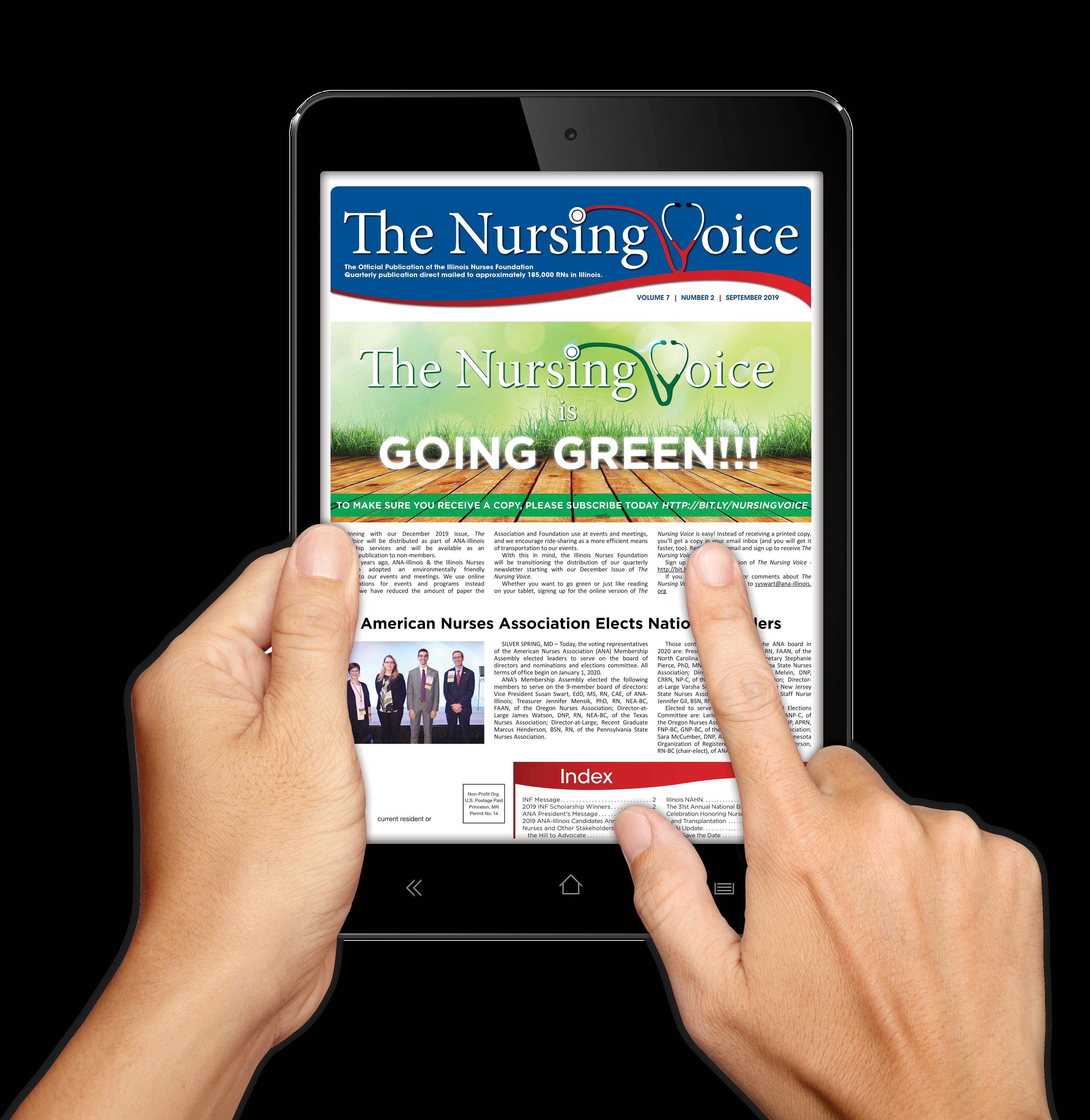

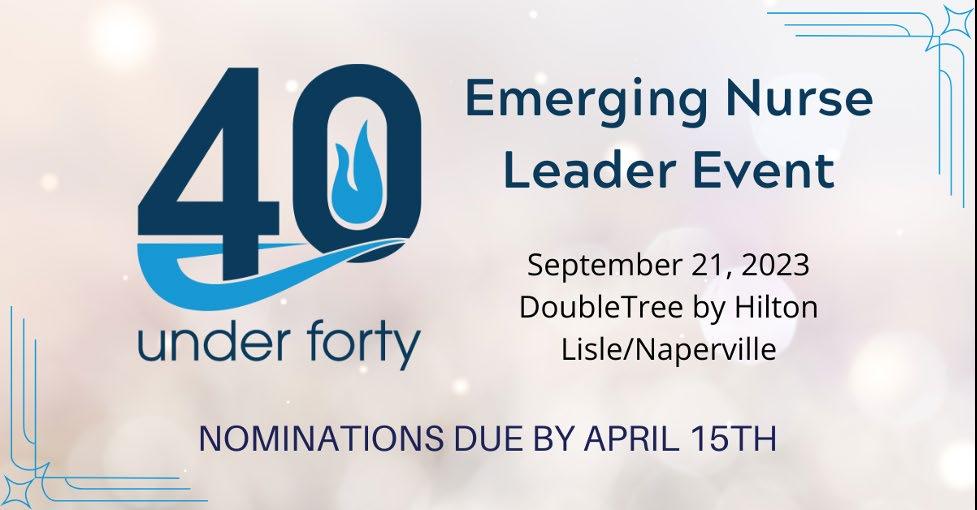
Please take a moment today to nominate a nurse deserving of recognition for the work they do.
The Illinois Nurses Foundation is accepting nominations for the 9th Annual 40 Under 40 Emerging Nurse Leader Awards. The awards will recognize 40 Illinois RNs younger than 40 who positively represent their profession by participating in the community as well as professional organizations. Nominations are due April 15, 2023.
Winners will be chosen by their peers based on the following criteria: Positively represent the nursing profession by actively participating in the community and/or a professional organization.
The award is designed to recognized nurses in Illinois who demonstrate exemplary professional practice along with community engagement and/or advocacy on behalf of the profession and those we serve.
Awards will be presented on September 21, 2023.
Nominate someone today - https://portal4nurses.com/awards/inf/forty-under-forty

W.
Zeh Wellington, DNP, RN, NE-BC
Is medicine going to the dogs? Yes, but in a good way. Pet therapy is gaining fans in health care and beyond.
The definition of a therapy dog is beneficial to understand: Animal therapy is any type of therapeutic intervention that incorporates animals. This may include support with physical, social, emotional, or cognitive functioning. It can be used alone or as part of a treatment plan with other interventions.

These animals are specifically trained to provide affection and comfort. They are often confused with service animals and emotional support animals, but all three are different. The primary difference between therapy animals and service animals is that therapy animals provide emotional support while service animals provide assistance to people with disabilities by performing specific tasks. For example, a service animal may help a blind person navigate their surroundings or alert someone with epilepsy that they are about to have a seizure. (Olivine, 2023, para. 1-3)
The optimism and happiness a therapy dog visit can provide to a patient is one that cannot be measured by a doctor’s instruments or recorded on a patient’s chart. However, it is clear to those who have had the experience of this special visitor . . . a wagging tail can make all the difference in the world.
Imagine you're in the hospital, and you get a visit from one of our prestigious guests of honor, a furry, four-legged friend. After the visit, you realize you are smiling. You feel a little less tired and a bit more optimistic. You cannot wait to tell your family and all your friends about your charming new canine friend. In fact, you are already looking forward to the dog's next visit.
Animal-assisted therapy can significantly reduce pain, anxiety, depression, and fatigue in people with a range of health problems. Olivine (2023) went on to say in her article that there are many benefits of animal therapy that go well beyond feelings of comfort and emotional support. Studies have found animal therapy to effectively help people to relax, have breakthroughs in the talk therapy process, lower blood pressure and slow heart rate, regulate hormones, and improve interactions and behaviors, among other things.
Dog therapy has been doing a brilliant job for many years assisting young and old patients alike. Having therapy dogs in the hospital helps normalize the setting for children who are away from home under scary and unpleasant circumstances. Families and staff benefit from the visits, as well. The therapy dogs provide a tremendous enhancement to joy and morale.
Often a dog, large or small, is the last thing a child expects to see in their hospital room. You will often find that your dog poses for pictures during most of your visits, and sometimes will even accept a treat . This loveable dog is a perfect diversion from the routine of their hospital stay.
A special thank you to all of our compassionate, caring, kind and loving handlers who escort our therapy pets around the floors of the hospital to make a difference in each patient’s day. Children are amazingly resilient - they inspire us with their strength and courage to face their challenges. Parents often report that when their child saw the therapy dog, it was the first time they smiled since they had been admitted to the hospital. I think we have the opportunity to see a lot of doggie smiles, too.

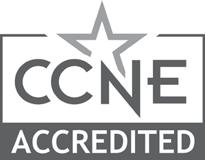
So today I say thank you to all our 4-legged friends who have joined in our charge and commitment to genuine and kind care. Thank you for joining us in the wellness and good health for all our patients – young and old. So yes, I am happy top say….Medicine is going to the dogs.
Reference Olivine, A. (2023). What Is animal therapy? Pet therapy, animal-assisted therapy, pet-assisted therapy. Verywell Health. https://www.verywellhealth.com/animal-therapy-5212800
W. Zeh Wellington, DNP, RN, NE-BC is Director of Procedural Care and Surgical Services at the Ann & Robert H. Lurie Children’s Hospital of Chicago
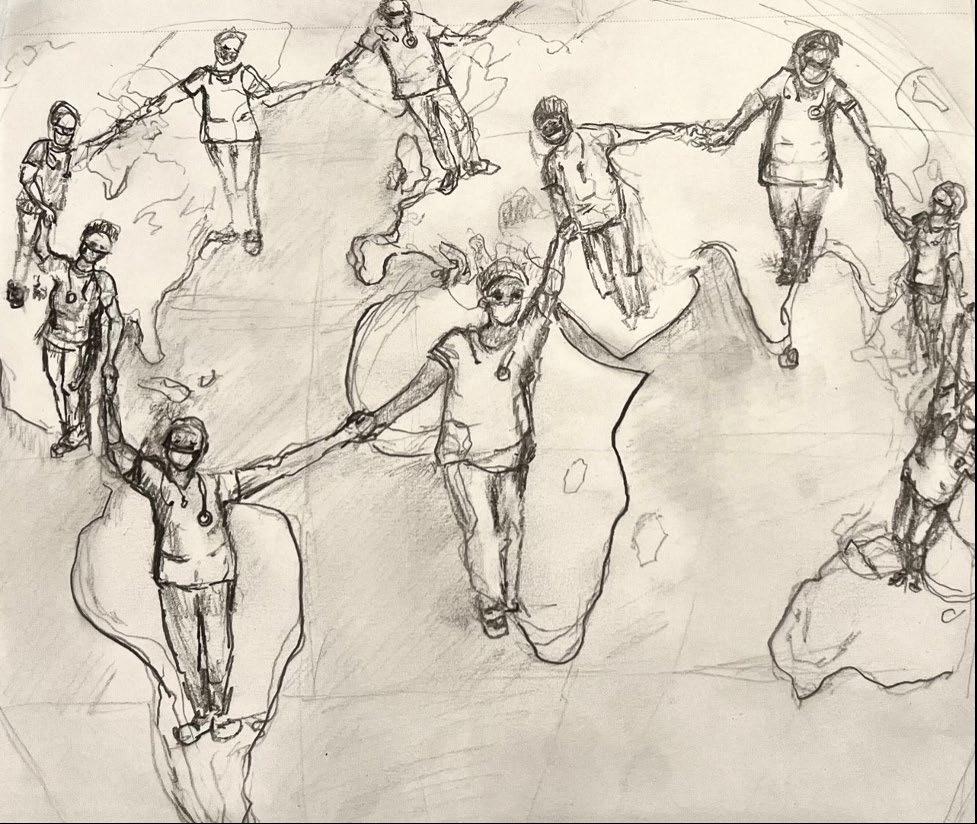

NANCY J. BRENT, MS, JD, RN
According to the National Institute of General Medical Studies (n.d.), genetics is the study of genes and heredity— of how certain qualities or traits are passed from parents to off-springs as a result of changes in DNA sequence. When such changes result in congenital anomalies in a newborn, it is essential that medical care and treatment begin as soon as possible.
Newborn Metabolic Screening in Illinois Illinois has passed legislation to meet the challenge of identifying congenital anomalies in all newborns through its Newborn Metabolic Screening Act and its Administrative Rules. The Illinois Department of Public Health (IDPH) is designated as the state agency to administer the act.
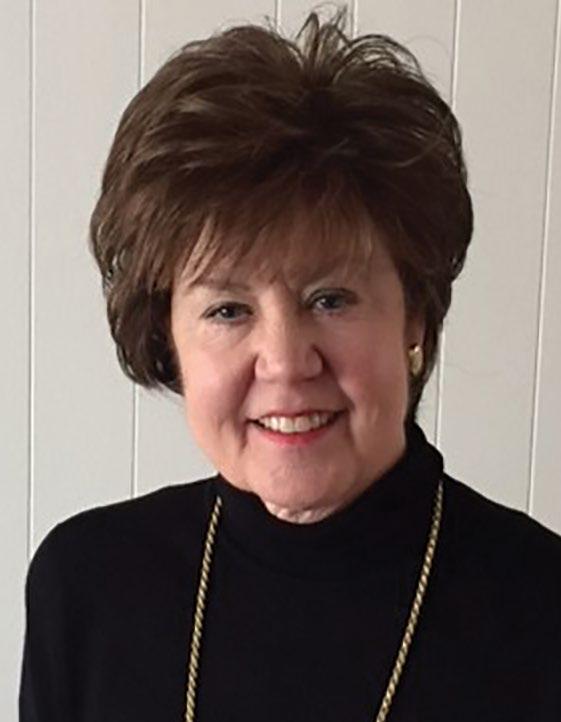
Nancy J. Brent, MS, JD, RN
The Act lists those conditions that are to be screened by a blood spot specimen as soon as possible after the first 24 hours of life. They include:
• Critical Congenital Heart Defects (at birthing hospitals and birth centers)
• Lysosomal Storage Disorders
• Severe Combined Immunodeficiency Disease (SCID)
• Mucopolysacchardosis Disorders
• Adrenoleukodystrophy
• Spinal Muscular Atrophy
The legislation also requires IDPH to:
• Provide educational programs to physicians, hospitals, public health nurses, and the public concerning the disorders included in newborn screening
• Supply necessary metabolic treatment formulas “where practicable” for diagnosed cases of amino acid metabolic disorders and fatty acid oxidation disorders as medically indicated when such formulas are not available through other State agencies
• Arrange for or provide public health nursing, nutrition, and social services and clinical consultation as indicated

We would like to recognize and thank the following donors who were instrumental in helping us achieve our goals in 2022. Because of their general support we gave away over $5,000 in scholarships and awarded $13,000 in grants through our grant program.
Ann Altgilbers
Jose Alejandro
Lisa Anderson Shaw
Cheryl Anema
Laurie Anema
Elizabeth Aquino
Antonette Baiardo
Pam Brown
Colleen Burke
Nadine Butler
Lisa Capps
Karen Carroll
Brittany Chimis
Beth-Ann Christopher
Evelyn Collier-Dixon
Lisa Conley
Maria Connolly
Melinda Cooling
Marilou Dangalan
Charles DiMartino
Pam DiVito-Thomas
Karen Egenes
Ken Etski
Audrey Finkel
Daniel Fraczkowski
Chad Frederick
Yolanda Frontany
Susana Gonzalez
Jeannine Haberman
Constance Hall
Robin Hannon
Brandon Hauer
Bridget Heroff
Keith Hill
Andrea Hinich
Susan Huerta
Joanne Jackson
Karen Kelly
Vicki Keough
Joan Libner
Lara Long
Erica Mansavage
Patricia McGuigan
Penny McNicol
Kim Mettache
Margaret Miller
Robert Mitchell
Lori Mojica
Catherine Mombrun
Eileen Moss
Corey Naeger
Judith Nykiel
Shevawn O'Connor
Emmanuel Olaifa
Amanda Oliver
Linda Olsen
Ann O'Sullivan
Timothy Ozlowski
Annie Pecoraro
Jacob Pierce
Celia Rademacher
Linda Roberts
Dawn Romano
Arlene Ryndak
Finally, the Act’s provisions do not apply if a parent or guardian of the newborn objects to its requirements due to a conflict with their “religious tenets and practices.” This is the only exception to testing. There must be a written statement of such objections given to the physician or other person whose duty it is to administer and report the required test results to IDHP’s Newborn Screening Laboratory in Chicago. Moreover, the written objection must be maintained by the facility of birth or by the primary health care provider.
Illinois Nurses’ Screening Obligations
Illinois nurses play an important role in newborn screening. IDPH’s Newborn Screening Practitioner’s Manual lists specific obligations for specific nurses. If a licensed nurse midwife is the practitioner attending the birth of the newborn, they have primary responsibility for collecting the blood specimen at the appropriate time.
If a newborn birth occurs outside of a hospital or birthing facility or there is no physician or licensed midwife at the birth, the health care provider caring for the newborn is responsible for collecting the blood specimen at the appropriate time. Home health care agencies need to develop policies and procedures to ensure that home health care nurses obtain the results of any screening done prior to the first home visit.
Illinois Nurse Responsibilities
Illinois nurses who provide care in maternal-newborn nursing need to be familiar with the State’s requirements of their role with newborn screening. These requirements must be carried out within their respective scopes of practice as defined by the Illinois Nurse Practice Act and its Administrative Rules. Reviewing the Illinois scope of practice definitions for both the RN and the APRN on a regular basis, then, is essential. Also important is maintaining continued competency in their respective roles so that newborns and their parents receive quality care during screening and treatment.
Association of Women’s Health, Obstetric and Neonatal Nurses (AWHONN) Position Statement on Newborn Screening
AWHONN lists other responsibilities for Illinois nurses to include:
• Explaining the importance and implications of testing to parents-to-be
• Counseling and educating families about newborn screening tests
• Collecting blood spot specimens by conforming to collection techniques and state requirements
• Completing required information on the blood spot collection device as needed
• If additional screening tests are required, assisting with their collection
You can read the Illinois Screening Act and Rules at dph/illinois.gov/topicsservices/life-stages-populations/newborn-screening.html (click on Laws and Rules). The IDPH Newborn Screening Practitioner Manual is located at https://illinois.gov/ content/dam/soi/en/web/idph/files/publications/publications-ohpm-practitionersmanual-2015-042116.pdf. The AWHONN Position Statement is at https://dx.doi. org/10.1016/j.jogn215.11.004
Reference
National Institute of General Medical Sciences (n.d.) Genetics. https://nigms.nih.gov/education/ fact-sheets/Pages/genetics.aspx
This information is for educational purposes only and is not to be taken as specific legal or any other advice by the reader. If legal or other advice is needed, the reader is encouraged to seek such advice from a nurse attorney, attorney or other professional.
Ruthann Sanders
Jennifer Sandoval
Laurel Schaap
Jane Serwa
Maureen Shekleton
Tammi Stancik
Susan Swart
Mildred Taylor
Mary Ann Tuft
Ethel Walton
Beth Wayant
Monica Wiley
Chakika Williams
Advocate Aurora Health
ANA-Illinois
Arthur L. Davis Publishing Casey’s
CeraVe
Dam, Snell, & Taveirne, LTD
HealtheCareers
Lewis University
Loyola Medicine
National Association of Hispanic Nurses-Illinois
Old National Bank
Philippine Nurses Association of Illinois
Smits Funeral Homes, LTD
Stepping Stone Financial
Walter W. Schultz Agency, Inc
Witkowski Dental

In Honor Donations
Josie Corral
Diane Ferriss
Dr. Alma Joel Labunski
Stephanie Mendoza
Jaime Najera
Monica Najera
Rocio Sanchez
Memorial Donations
Darla Wilson Bahr
Nancy Bosco
Josephine "Jo" Hott
Adrienne Ozlowski
Ben Paterik
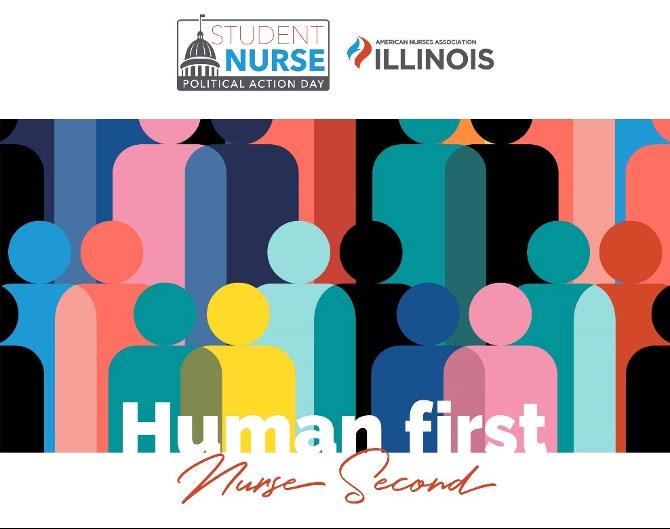
The American Nurses Association - Illinois (ANA-Illinois) is proud to announce that registration is open for “Student Nurse Political Action Day 2023: Human first, nurse second.”, to be held on April 18, 2023, in Springfield.
Each year, Student Nurse Political Action Day brings together hundreds of nursing students from across the state in Illinois’ capitol for a day of learning, networking, and advocacy. We are excited to gather in Springfield again this year.
Our 2023 event will:
● spark discussion, encourage learning, and foster connection.
● deliver relevant and timely content for the current state of nursing in Illinois.
● energize and fuel the growth of future nurse leaders!
The event is $35 to attend and open to student nurses of all ages.
KEYNOTE - Human First, Nurse Second - Navigating the Chaos – Presented by Susan Y Swart EdD, MS, RN, CAE
What will it take to succeed as a future clinical nurse?
How can you prepare yourself for today's healthcare environment?
How can the profession use innovative solutions to address nursing workforce issues?

This presentation will explore the reasons for the nursing shortage and the current state of the nursing workforce and nursing education in Illinois. We will discuss the future of care delivery, what it means to have a safe work environment and how we influence health equity, diversity, and inclusion. We will wrap up the session with a Q&A with the audience.
For more information or to register visit https://bit.ly/SNPAD2023
The Hektoen Institute Nurses & the Humanities group and the Academy of MedicalSurgical Nurses (AMSN) Chicago Chapter #317, in celebration of 2023 Nurses Month will have a number of celebratory activities at the International Museum of Surgical Sciences (IMSS), located at 1524 N Lake Shore Drive, Chicago, IL.
Nurses & the Humanities was founded in June 2006 to present programs that demonstrate and encourage the healing power of the arts and humanities for caregivers and their patients, as well as for nurses (Programs addressing diverse themes of nursing and the humanities (art, literature, history, philosophy, music, theater, and dance) have various formats. These include lectures, workshops, classes, and excursions. The programs are geared toward nurses, caregivers, healthcare professionals, and nursing students, and are open to the general public.
The Hektoen website is https://www.hektoen.org/nurses-the-humanities where information on past programs can be viewed. The website for the Chicago chapter of the AMSN, which was founded in 2008, is https://amsn317.nursingnetwork.com Hektoen Nurses & the Humanities and the AMSN offers programs in collaboration with each other.
Further information will follow, and all nurses and others are invited. In addition, if you have a nursing professional you would like to honor or celebrate during nurses week, please feel free to reach out to Cora Palmer cjpalmer17@icloud.com for details before Feb. 26, 2023.
Here are some events that are already scheduled: May 4, 2023: Opening ceremony (surprise speaker) May 11, 2023: 5-8pm. Judith A. Paice PhD, RN Director of Cancer Pain program Division Hematology Oncology Northwestern University Feinberg School of Medicine Fireside Chat: “Pain Lessons for our Future”. The Wine & Cheese reception follows, from 5-6:00pm.
May 13, 2023: 11am-1pm. Rachel Gage, MA, MSN, APNP, AGPCNP-BCL, “Leverage Your Best Self” Join us for Tea with Rachel at IMSS.
Please register through the IMSS website! https://imss.org/programs

Department Overview: The Department of Registration and Education was established on July 1, 1917. The Department’s name was changed to Department of Professional Regulation in 1988, and to Department of Financial and Professional Regulation, Division of Professional Regulation in 2004. The Division of Professional Regulation is divided into two operating units with specific duties and responsibilities: Licensing and Testing, and Statewide Enforcement. For more information, please see the Division of Professional Regulation resource brochure https://idfpr.illinois.gov/ Forms/Brochures/DPR.pdf
• Tips for first time registration for individual online account matching process https://idfpr.illinois.gov/ Forms/Online/Renewal%20Tips%20Individual%20 Accounts%202021-12-15.pdf
For most licensees this will be the first time logging into your IDFPR Online Services Portal Account. You will need to Register and MATCH to your existing license record. If you applied for your initial license via the IDFPR portal, you can use the username and password created at that time. For those requiring additional assistance with the login process, please contact IDFPR by emailing fpr.lmu@illinois.gov. Please enter "RENEWAL" in the subject line of your e-mail.
• To print your license or download an electronic copy to your phone, just head to the IDFPR website https://idfpr.illinois.gov/applications/getmylicense/ LoginProf.asp?ViewOption=ind
• To change your email address, address or phone number, please click on this link to update the information https://idfpr.illinois.gov/applications/ LicenseReprint/
• The Illinois Department of Financial and Professional Regulation (IDFPR) knows how critical it is to military families to begin working as soon as they come to the Prairie State.
Illinois law includes several provisions designed to help military Service Members and Spouses who are an active duty member or whose active duty service concluded within the preceding 2 years before application. One of these laws states that once you or your spouse have submitted all the required documents and fee as part of your license application, your application will be reviewed within 30 days. In addition to expedited review of your application, the Department’s dedicated Military Liaison will work with you and your military installation’s military
and family support center to help you through the licensing process. https://idfpr.illinois.gov/Military.asp
• On the IDFPR Division of Professional Regulation Nurses webpage, the “Requirements of an Internationally Educated Nurse” document has been updated. Resources on this document include the names of Board of Nursing approved vendors for items required to apply for an Illinois nurse license. Information includes that endorsing an active license from another state requires: an application by Endorsement. A Credential Evaluation Service (CES) Report is not required if the state of original licensure required a report at the time of original licensure. An English equivalency test is not required as long as the nurse applying for endorsement took and passed the NCLEX® licensure examination.
• On the IDFPR Nurses web page there is a list of all 132 Illinois Board of Nursing approved pre-licensure nursing education programs https://idfpr.illinois. gov/Forms/DPR/NurseSchools.pdf
• The list of health care professional temporary practice permits granted in Illinois may be found here: https://www.idfpr.com/Forms/COVID19/ Temp%20Practice%20Permits.pdf
• IDFPR’s Division of Professional Regulation has issued a notice, “Notice that Advice or Treatment Regarding Covid-19 Must conform with EvidenceBased Medicine and Standards of Care,” to remind physicians and other healthcare professionals that any advice or treatment provided to a patient must conform with evidence-based medicine and standards of care and that failure to do so may subject the individual to disciplinary action. Licensed healthcare professionals have an ethical and professional duty to the public and are entrusted to protect the public health and the safety of patients. IDFPR is aware of licensed healthcare professionals providing misinformation regarding COVID-19 mitigations and treatment. https://www.idfpr.com/Forms/COVID19/IDFPR%20 statement-physicians.pdf
• Variance: The Healthcare License Reinstatement Application is specific to the COVID-19 Pandemic and limited to prior State of Illinois licensees who were in good standing, including: Licensed Practical Nurse, Advanced Practice Registered Nurse, and Registered Nurse. The license must have been on an “inactive” status for less than five years. The COVID-19 license will have an expiration date
of May 31, 2022 or until the expiration of the Gubernatorial COVID-19 Disaster Proclamations. There is no fee to apply https://idfpr.com/ Renewals/Apply/Forms/F2396.pdf
• The State of Illinois Coronavirus Response Site: The COVID-19 Vaccine Plan, up-to-date information on what Illinois is doing protecting the health, safety, and well-being of Illinoisans can be found at https://coronavirus.illinois.gov/s/. This page includes the CDC’s new vaccine finder tool which shows you the closest location to get a vaccination; with this finder you can filter by manufacturer, which makes it easy to protect children who are not eligible for the Pfizer vaccine.
• Complaints against any individual or entity regulated by the Division of Professional Regulation may be filed by contacting the Complaint Intake Unit. For a complete list of professions regulated by DPR, please click https://idfpr.illinois.gov/Forms/ Brochures/DPR.pdf
Please note: Pursuant to Illinois law (20 ILCS 2105/2105-117), all information collected by the Department during an examination or investigation of a licensee, registrant, or applicant is confidential and cannot be publicly disclosed. This includes complaints and any information collected during an investigation. Exceptions to this law exist only for law enforcement, other regulatory agencies with appropriate regulatory interest, or a party presenting a lawful subpoena. Division of Professional Regulation online complaint form: https:// idfpr.illinois.gov/Admin/DPR/Complaint.asp
• A complete copy of the Nurse Practice Act and the Rules may be found on the IDFPR website www. idfpr.com or on the Illinois Nursing Workforce Center’s website http://nursing.illinois.gov/ nursepracticeact.asp
• The Illinois Department of Financial and Professional Regulation (IDFPR) is providing renewal assistance for individuals and businesses that are having difficulty with the online renewal process. These steps will help licensees better navigate the account matching process on the Department's updated online portal. For those requiring additional assistance, please email: fpr. lmu@illinois.gov
o Assistance for Individuals: https://bit. ly/3mb8C7U
o Assistance for Businesses: https://bit.ly/3E5Fll8
Are you a Registered Nurse (RN) licensed in Illinois who is looking for an opportunity to share your knowledge and experience with future nurses?
The Illinois Nursing Workforce Center (INWC) is teaming up with higher education institutions across the Land of Lincoln to bring YOU a series of FREE webinars about the graduate faculty nursing programs in Illinois for you to consider!
The Wednesday February 15 webinar features Benedictine University, DePaul University, Chamberlain College of Nursing and Millikin University. Explore the programs and find the right one for you by signing up for the webinar here: https://ILGraduateNursing3.eventbrite. com Signup is limited to the first 100 registrants.
The October 2022 webinar featured Elmhurst College, Rush University College of Nursing, Southern Illinois University -Edwardsville School of Nursing, and St. Xavier University-DE School of Nursing and Health Sciences. All webinars are available on IDFPR’s YouTube page https:// www.youtube.com/user/IDFPRmedia
The December 2022 webinar featured Lewis University, Mennonite College of Nursing at Illinois State University, St. Francis Medical Center College of Nursing and University of Illinois – all six campuses. https://www. youtube.com/watch?v=0R4gkGJ72vc
Each webinar panel member shares essentials such as program entry requirements, per cent of classes online, balance of current work, classes and requirements with family and professional development. These webinars will continue every other month through at least June 2023. Each webinar will present a panel of faculty from graduate nursing education programs across the state. Please join us in preparing future nurses.
The Illinois Nursing Workforce Center website includes links to:
• Grid of graduate nursing education programs https://nursing.illinois.gov/Gradeducation.asp
• Grid of graduate nursing education programs with focus areas leading to systems focused roles https://nursing.illinois.gov/PDF/2022-06-08a_ INWC_Grad_NsgEd_FocusAreaLeadSystFocusRole_ Ltrhd.pdf
• Established relations with community colleges across the state, useful for transfer of credits to the graduate program https://nursing.illinois.gov/ PDF/2020-05-06_ILBSNcPgms_Partnerships_Final. pdf
• IDFPR nurse page https://idfpr.illinois.gov/PROFS/ Nursing.asp
Georgia Reiner, MS, CPHRM, Risk Analyst, Nurses Service Organization (NSO)
Throughout their careers, nurses, nurse practitioners, and other nursing professionals will encounter challenging situations at work that present ethical dilemmas. Deciding what to do in these situations can cause significant stress, as the appropriate course of action can vary depending on each unique set of circumstances. This article reviews a model that nursing professionals can use as a guide to help them gain a better understanding of conflicting issues and navigate ethical dilemmas.
Key ethics principles
Below are key ethical principles nurses should know:
• Autonomy. This addresses self-determination, allowing the person the freedom of choice and action. It is important to help patients understand the implications of their decisions and to ensure that family members not pressure patients to make a choice. In addition, if you feel a person is not capable of making a decision, follow organizational policy to determine an appropriate surrogate decision-maker.
• Beneficence. This refers to “doing good.” Although this principle seems simple, it is not always easy to determine what is “good” in an ethical dilemma. Beauchamp and Childress state that beneficence includes protecting and defending the rights of others, preventing harm from occurring to others, removing conditions that will cause harm to others, helping people with disabilities, and rescuing persons in danger.
• Nonmaleficence. This principle refers to not causing harm to others, including not inflicting intentional harm and not engaging in actions that risk harming others. One way to address this principle is to weigh potential harm against potential benefits. The goal is to select interventions that create the least amount of harm to obtain the most beneficial outcome.
• Fidelity. Honoring commitments is the focus of fidelity. Fidelity incudes acting with caring and being honest; patients need to feel they can trust you. For example, if a patient does not want to share her advanced cancer diagnosis with family members, you should honor that wish.
• Justice. Justice does not mean treating everyone the same. Rather, it means treating a person in a way that meets his or her individual needs. Examples include providing education materials in patients’ preferred language and offering free flu shots to those in need.
Nurses are well aware of patients’ rights, such as the right of patients for self-determination (the right to make decisions about their own care). This right has even been codified in law as a result of the Patient Self-Determination Act (PSDA) of 1991, which requires healthcare agencies receiving Medicare and Medicaid reimbursement to provide information about advance directives. Patients’ rights, like self-determination, also play a role in ethics. For example, Provision 1.4 of the American Nurses Association (ANA) Code of Ethics for Nurses with Interpretive Statements (the Code) states that the patient has a right to self-determination.
In the clinical setting, ethical conflicts related to self-determination and other ethical principles are not unusual. Consider these possible scenarios: A family member disagrees with an advance directive that a patient completed now that the patient is unable to speak for themself. A patient declined to receive a potentially life-saving treatment even after receiving information about the process. A nurse wonders if a patient has received enough information from the physician to truly give informed consent. How can these types of ethical dilemmas be resolved? Taking a systematic approach can help you navigate toward a decision, but first it is useful to understand how legal issues relate to ethical principles.
Even though the Code relates to ethics and not the law, attorneys could turn to it for evidence that a nurse’s behavior did not meet the standard of care. For example, the Code states, “Nurses preserve, protect, and support those rights by assessing the patient’s understanding of the information presented and explaining the implications of all potential decisions.” If you fail to act when you think a patient did not receive enough information about a treatment decision, you could be held liable.
In addition, keep in mind that principles such as selfdetermination and patient autonomy applies not only to end-of-life care but to all treatment decisions. Therefore, going against a patient’s wishes could put you in legal jeopardy. For example, drawing blood from a patient who states he does not want lab work done could be considered battery.
To help avoid legal peril, use a systematic approach to making ethical decisions, based on ethical principles (see Key ethics principles). One such approach is a framework for ethical decision making from the American Counseling Association (ACA). While written for counselors, the framework outlines seven steps any healthcare professional can use to approach ethically ambiguous situations:
#1. Identify the problem.
To identify the problem, you first need to gather information related to the situation. Focus on facts, not assumptions. Consider whether the issue is related
to yourself and what you are doing (or not doing) or is related to the patient or the patient’s loved one and what they are doing or not doing. For example, in the case of a young teenager who has not been informed he has brain cancer at the request of his parents, an ethical issue relates to the dynamics of the parents not wanting the diagnosis to be shared and the healthcare professionals who must consider the impact on the patient.
Be sure you are truly facing an ethical problem and not a clinical, legal, or professional one or a combination. Other considerations include whether the issue is related to technology (e.g., mechanical ventilation) or organizational policy. For example, legal statutes and organizational policy related to removing a patient from life support could conflict with what you see as the right ethical path. If there is any element of a legal issue involved, be sure to consult your organization’s risk management or legal department, or an attorney.
#2. Apply the code of ethics.
Once you have identified the problem, turn to the Code. In some cases, the answer may be there. For example, a patient gives you a computer tablet as a thank-you gift. You had wanted to purchase a new tablet to replace your old one, but you are unsure if you should accept the gift. Provision 2.4 of the Code states, “Accepting gifts from patients is generally not appropriate.” The provision goes on to state that one factor to consider is the value of the gift. The cost of a tablet means you should decline the gift. (In addition, your organization likely has a policy that prohibits gifts from patients.)
You should also consider other relevant codes that might apply. For example, the American Association of Nurse Anesthetists has their own Code of Ethics for the Certified Registered Nurse Anesthetist.
If the issue is not resolved by codes of ethics, you will need to move on to the next step.
#3. Determine the nature and dimensions of the dilemma. To accomplish this task, analyze the dilemma in terms of ethical principles. Determine which principles apply and which have priority in this case. For instance, a patient with a history of chronic pain is asking for an early refill of his narcotic prescription. Granting the prescription might meet the principle of beneficence in the short term by providing pain relief but could violate the principle of nonmaleficence by putting the patient at risk of substance misuse.
As part of your analysis, consider consulting the literature to ensure current, evidence-based practice. Thinking and consulting with colleagues or managers can also help you see other points of view. Another excellent resource is your organization’s ethics committee. In certain situations, you may even want to consult with your state or national professional association for input.

Rosalind Franklin University continues to lead, inspire and compassionately educate a diverse student body of healthcare professionals in announcing the new College of Nursing
#4. Generate potential courses of action. This is the time for brainstorming ideas for actions to take. Write the ideas down without taking time to consider whether they are viable. Having another colleague help you with this step is a good idea.
#5. Consider the potential consequences of all options and determine a course of action.
Now you should evaluate the potential courses of action you identified. Consider each option in the context of the information you have and evaluate the positive and negative effects of the option in relation to ethical principles you have identified. You will also want to evaluate each action for the potential effects on you, the patient, and any others who will be affected, for example, the patient’s family or the organization. It may be helpful to write a list of pros and cons for each option.
Toss out options that are problematic and take a closer look at the remaining ones, ultimately picking the one that best fits the situation.
#6. Evaluate the selected course of action.
Once you have chosen a course of action, test it to determine if it truly is the best option. The three “tests” are justice, publicity, and universality:
• To apply the test of justice, consider your own sense of fairness and whether you would treat others the same in the situation.
• To apply the test for publicity, ask if you would want your behavior reported in the media.
• And to apply the test for universality, consider whether you would recommend the same course of action to another nurse.
If your option does not fulfill all three tests, return to the start of the process. You may find that you did not properly identify the problem. If your choice met the tests, you are ready to move forward.
#7. Implement the course of action.
Know that just because you feel the action is the right one does not mean it will be easy to carry out. You may need to engage in stress reduction techniques before and after the action.
Here is a summary of the seven steps to ethical decision-making:
#1. Identify the problem.
#2. Apply the code of ethics.
#3. Determine the nature and dimensions of the dilemma.
#4. Generate potential courses of action.
#5. Consider the potential consequences of all options and determine a course of action.
#6. Evaluate the selected course of action.
#7. Implement the course of action.
Download an infographic outlining the process at www.counseling.org/docs/default-source/ethics/ethicaldilemma-poster_fa.pdf?sfvrsn=2. While the process was written for counselors, the same principles can apply to nursing if you simply substitute the American Nurses Association Code of Ethics with Interpretive Statements for the American Counseling Association Code of Ethics.
Once the action is completed, determine if the result was what you anticipated. This is a good opportunity to learn how be more effective in making ethical decisions in the future.
Ethical dilemmas can cause significant distress, even when managed appropriately. To reduce distress, follow a step-by-step approach to making decisions. Consult your manager or your organization’s risk management or legal department for assistance. And if there are significant legal concerns involved, it may be useful to consult an attorney before proceeding.
RESOURCES
American Association of Nurse Anesthetists. (2018). Code of Ethics for the Certified Registered Nurse Anesthetist. www. aana.com/docs/default-source/practice-aana-com-webdocuments-(all)/code-of-ethics-for-the-crna.pdf
American Nurses Association. (2015). Code of Ethics with Interpretive Statements. www.nursingworld.org/practicepolicy/nursing-excellence/ethics/code-of-ethics-for-nurses/ coe-view-only
Beauchamp T.L., & Childress J.F. (2019). Principles of Biomedical Ethics, 8th edn. New York, NY: Oxford University Press;. Beemsterboer, P. (2018). Ethics in dentistry: Part III – Ethical decision making. DentalCare.com. www.dentalcare.com/ en-us/professional-education/ce-courses/ce546/ethicaldecision-making-models Davis, C. (2018). Ethical decision-making. Nurs Made Incredibly Easy, 16(2), 4-5. https://journals.lww.com/ nursingmadeincrediblyeasy/Fulltext/2018/03000/Ethical_ decision_making.1.aspx
Forester-Miller H., & Davis, T.E. (2016). Practitioner’s Guide to Ethical Decision Making (rev. ed.). American Counseling Association. www.counseling.org/docs/default-source/ ethics/practioner-39-s-guide-to-ethical-decision-making. pdf?sfvrsn=f9e5482c_10
Teoli, D., & Ghassemzadeh, S. (2019). Patient self-determination act. StatPearls. https://www.ncbi.nlm.nih.gov/books/ NBK538297/
Disclaimer: The information offered within this article reflects general principles only and does not constitute legal advice by Nurses Service Organization (NSO) or establish appropriate or acceptable standards of professional conduct. Readers should consult with an attorney if they have specific concerns. Neither Affinity Insurance Services, Inc. nor NSO assumes any liability for how this information is applied in practice or for the accuracy of this information. Please note that Internet hyperlinks cited herein are active as of the date of publication but may be subject to change or discontinuation.
This risk management information was provided by Nurses Service Organization (NSO), the nation's largest provider of nurses’ professional liability insurance coverage for over 550,000 nurses since 1976. The individual professional liability insurance policy administered through NSO is underwritten by American Casualty Company of Reading, Pennsylvania, a CNA company. Reproduction without permission of the publisher is prohibited. For questions, send an e-mail to service@nso.com or call 1-800-247-1500. www.nso.com

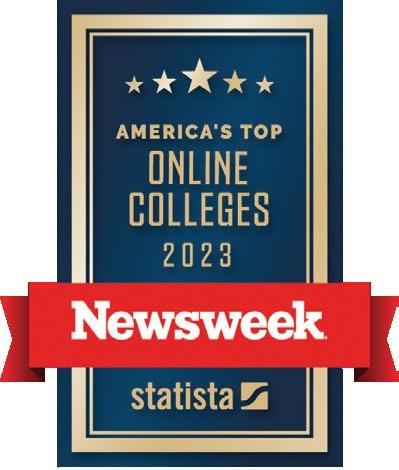
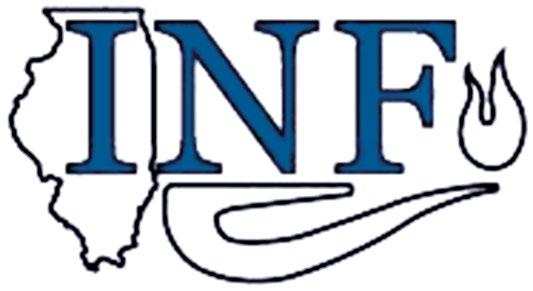

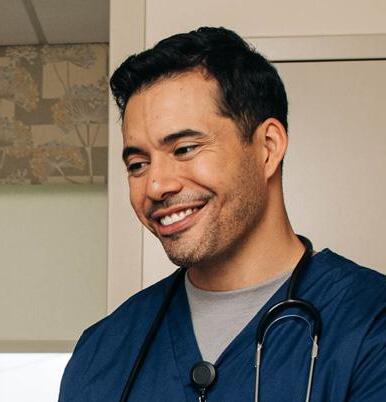


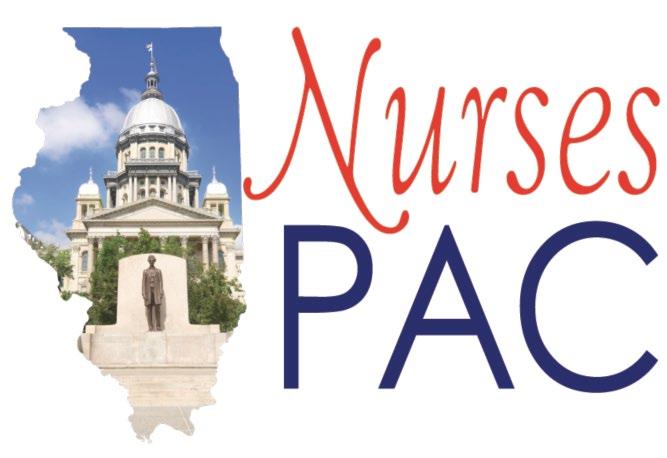
Nurses want to provide quality care for their patients.
The Nurses Political Action Committee (Nurses- PAC) makes sure Springfield gives them the resources to do that.
Help the Nurses-PAC, help YOU!
So. . . . . . . if you think nurses need more visibility if you think nurses united can speak more effectively in the political arena if you think involvement in the political process is every citizen’s responsibility.
Become a Nurses-PAC contributor TODAY!
❑ I wish to make my contribution via personal check (Make check payable to Nurses-PAC).
❑ I wish to make a monthly contribution to NursesPAC via my checking account. By signing this form, I authorize the charge of the specified amount payable to Nurses-PAC be withdrawn from my account on or after the 15th of each month. (PLEASE INCLUDE A VOIDED CHECK WITH FORM)
❑ I wish to make my monthly Nurses-PAC contribution via credit card. By signing this form, I authorize the charge of the specified contribution to Nurses-PAC on or after the 15th of each month.
❑ I wish to make my annual lump sum Nurses-PAC contribution via a credit or debit card. By signing this form, I authorize ANA-Illinois to charge the specified contribution to Nurses-PAC via a ONE TIME credit/debit card charge.
❑ Mastercard ❑ VISA
Credit card number Expires CVV
Signature:
Date:
Printed Name:
E-Mail:
Address:
City, State, Zip Code:
Preferred Phone Number:
Please mail completed form & check to:
ANA-Illinois
Atten: Nurses-PAC PO Box 636 Manteno, Illinois 60950

Georgia Reiner, MS, CPHRM, Risk Analyst, NSO
Nurses and nurse practitioners take pride in providing detailed information to patients to help them make treatment decisions. But what happens when patients don’t make what you think is the “right” choice? Ultimately, you need to respect the patient’s autonomy and right to choose (self-determination) even if you feel the patient isn’t making the best decision, for example, by refusing an important diagnostic test. Ideally, people will make the best choice for themselves and their loved ones. You can help them in that process (and reduce your own legal risk) by ensuring they have the information they need to make an informed decision.
Information, please
Consider this scenario: A patient decides to abruptly stop taking her prescribed betablocker because she “doesn’t like taking pills.” After developing rebound hypertension and tachycardia, she claims she wasn’t told of the possible adverse effects of not taking the medication. Unless you can point to documentation that shows the patient received education about the adverse effects of sudden stoppage, you could find yourself named in legal action.
To help avoid situations such as this and the others noted at the start of this article, provide education, which should be delivered in the patient’s preferred language. It’s also helpful to explain the concept of evidence-based care and to note research studies that support, for example, vaccination for HPV. The consumer summaries offered by the Agency for Healthcare Research and Quality (AHRQ) through its Effective Health Care Program (https://effectivehealthcare.ahrq.gov/consumers) are a resource for patientfriendly information about health conditions. Another resource is the patient section of the Choosing Wisely website (www.choosingwisely.org), where you can download patient information based on recommendations from leading specialty organizations.
Document all education that you provided in the patient’s healthcare record, as well as any use of translation services, and include that the patient or parent affirmed their understanding of the material. Follow your organization’s policies and procedures related to informed refusal or patients acting against medical advice to ensure you are fulfilling your duties.
When a patient refuses
Patients have a legal right to refuse care or to leave the hospital against medical advice. When the patient refuses, listen to the reasons and address them if possible. For instance, a patient who doesn’t fully understand a procedure may agree to it once they have additional information. It’s also essential to provide information about the consequences of the decision so you meet the criteria for “informed refusal” or leaving against medical advice, according to your employer’s policies and procedures. Otherwise, patients could later claim they were not told or did not understand the consequences of their decision.
Patients may choose to refuse treatments or diagnostic tests, to leave the hospital against the advice of their care providers. To reduce the risk of patient harm and the risk of possible legal action, follow these recommendations:
• Assess the patient’s ability to make decisions. If you are unsure, you may want to ask the patient to describe the reason for the visit, repeat back information given about treatment needs, and list basic personal information such as age, birthdate, and current address. If decision-making seems impaired, assess if the impairment is temporary (for example, due to medication effects) or long-term. Determine if the patient has designated a surrogate decision-maker.
• Listen to the patient’s reasons for wanting to leave or refusing treatment and address them as you can. For example, a patient may simply be frustrated by prolonged wait time in the ED. Avoid minimizing any of the patient’s concerns, criticizing them if they may be misinformed, or telling them they are wrong. Asking open-ended questions that invite people to find their own reasons for change tend to be more effective than strong-arming or shaming.
• Document details of the patient’s decision in the healthcare record. Note those present during the discussion, the patient’s stated reasons for the decision, and information provided, including education material and the specific risks of not following the recommended treatment or leaving the facility. Also, document questions from the patient and/or family and the answers you provided.
• Continue to provide care not related to the treatment refused. In addition, provide care until the patient leaves the premises; this includes discharge instructions, and if you are a prescriber, prescriptions for needed medications. Failure to do so could leave you open to charges of abandonment.
• Have the patient sign any form for leaving against medical advice that your organization requires and include it in the healthcare record. If the patient refuses to sign, note that on the form. Sometimes the act of asking to sign a form will change a patient’s mind.
• Remain calm and professional. Be kind and empathetic and use non-judgmental language.
• If possible, follow up with the patient to see how they are doing. Document the call.
Patients have a right to refuse care, but they also have a right to know the implications of their refusal. They also have the right to receive sufficient information before making decisions. You can facilitate optimal outcomes, and reduce your legal risk, by collaborating with patients in decision-making.
RESOURCES
CNA, NSO. (2018). Nurse Practitioner Claim Report: 4th edition. https://aonaffinity-blob-cdn. azureedge.net/affinitytemplate-dev/media/nso/images/documents/cna_cls_np_101917_cf_ prod_sec.pdf
Greensway D. (2017). Can’t stop your patient from leaving AMA? Today’s Hospitalist. https:// www.todayshospitalist.com/cant-stop-your-patient-from-leaving-ama
HealthIT.gov, National Learning Consortium. (2013). Shared decision-making fact sheet. www. healthit.gov/sites/default/files/nlc_shared_decision_making_fact_sheet.pdf
Litt, D. & Walters, S. (2021). Battling misinformation through health messaging. National Institutes of Health. https://www.nih.gov/about-nih/what-we-do/science-health-public-trust/ perspectives/science-health-public-trust/battling-misinformation-through-health-messaging Office of the U.S. Surgeon General, U.S. Department of Health & Human Services. (2022). A community toolkit for addressing health misinformation. https://www.hhs.gov/sites/default/ files/health-misinformation-toolkit-english.pdf
The Sullivan Group. Do’s and don’ts of AMA: patients who leave against medical advice. https:// blog.thesullivangroup.com/ama-patients-who-leave-against-medical-advice
Disclaimer: The information offered within this article reflects general principles only and does not constitute legal advice by Nurses Service Organization (NSO) or establish appropriate or acceptable standards of professional conduct. Readers should consult with an attorney if they have specific concerns. Neither Affinity Insurance Services, Inc. nor NSO assumes any liability for how this information is applied in practice or for the accuracy of this information. Please note that Internet hyperlinks cited herein are active as of the date of publication but may be subject to change or discontinuation.
This risk management information was provided by Nurses Service Organization (NSO), the nation's largest provider of nurses’ professional liability insurance coverage for over 550,000 nurses since 1976. The individual professional liability insurance policy administered through NSO is underwritten by American Casualty Company of Reading, Pennsylvania, a CNA company. Reproduction without permission of the publisher is prohibited. For questions, send an e-mail to service@nso.com or call 1-800-247-1500. www.nso.com.
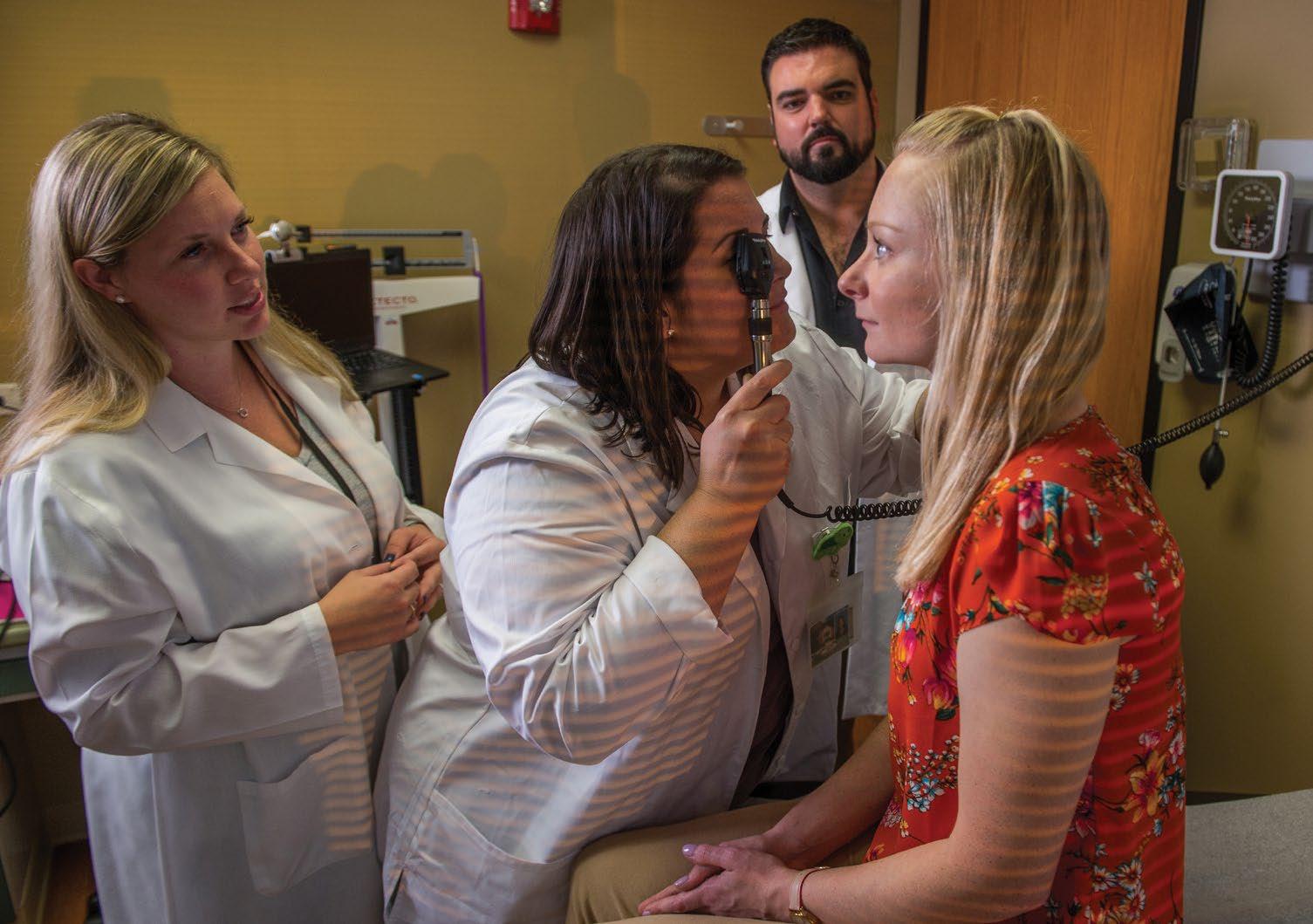



A. 1-4 self-scheduled shifts per month
B. 5+ self-scheduled shifts per month
Pick up shifts when it suits your lifestyle
Receive Holiday Pay
NEW PIB OPTION
Scheduled full-time or parttime
Signed agreement to accept higher pay in lieu of benefits (PIB)
Receive Holiday Pay